From a 300-foot drop to a dangerous climb, Mountainsmith Marketing Intern and VanLife Blogger Tasha Rivard takes a leap of faith into one of Moab, Utah’s famous canyons.
A few weeks ago, I jumped off a 300-foot cliff in Moab, Utah. I didn’t have a parachute. I did it intentionally.
I did have a Jumar, gri-gri, and all the other tools needed for self-ascending, though. I also had two 200-foot long ropes with one end knotted to my climbing harness and the other connected to a metal ring in the center of a high-line spanning the width of the canyon.
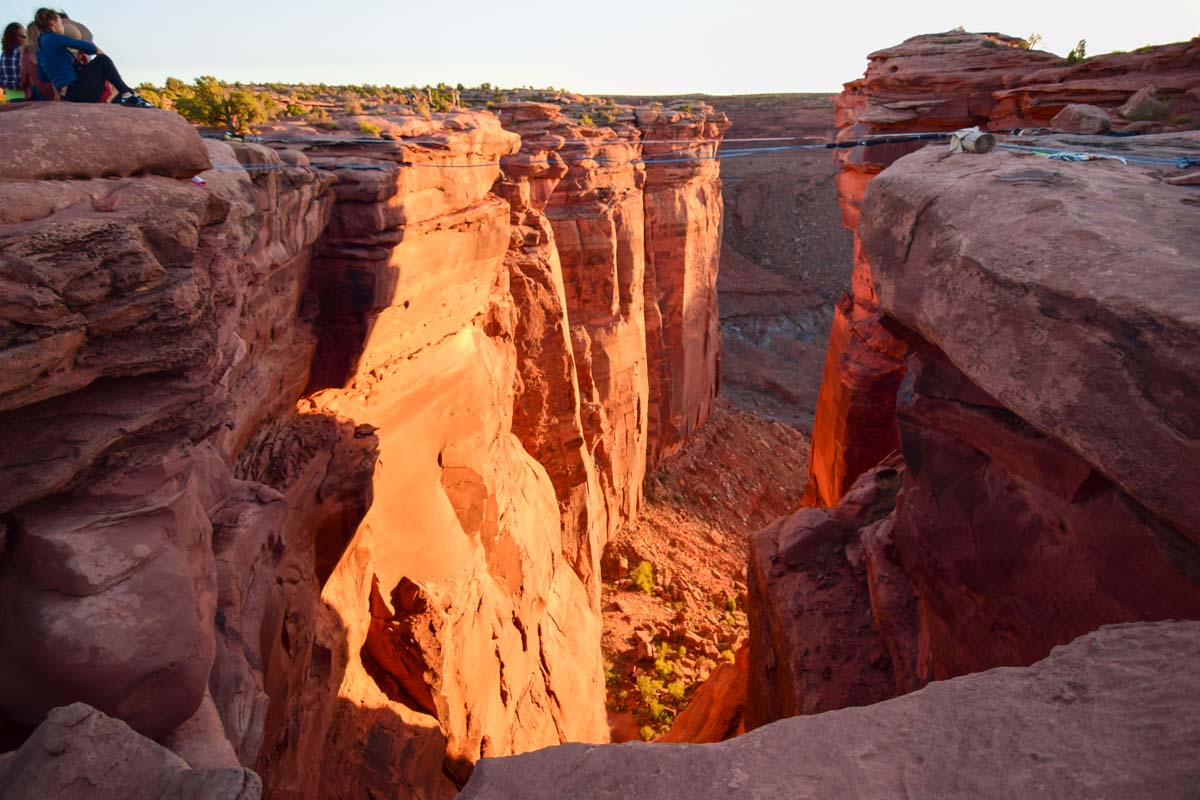
Night 1: The Gathering
The way the trip came together was oddly organic and coincidental. Originally, my friend Conor (a BASE jumper/climber) and I had driven out from Carbondale, CO to meet up with a friend of his in the desert. Our intention was to climb a couple of Moab’s more notorious towers, but lack of cell reception left us unable to track each other down. As a fallback we drove out to a notorious high-line spot and BASE exit point called the Fruit Bowl, where we ran into a few of Conor’s paragliding acquaintances, Pete and AJ, from Carbondale. Since the winds were howling and gusty, they had decided that rigging up some lines and a giant swing would be a better idea than flying. As the night progressed, we realized we’d stumbled into was a situation where one person knew one person who invited one person who brought one person – next thing we knew we were surrounded with a group of action-sport fanatics 15-deep in the middle of the desert.
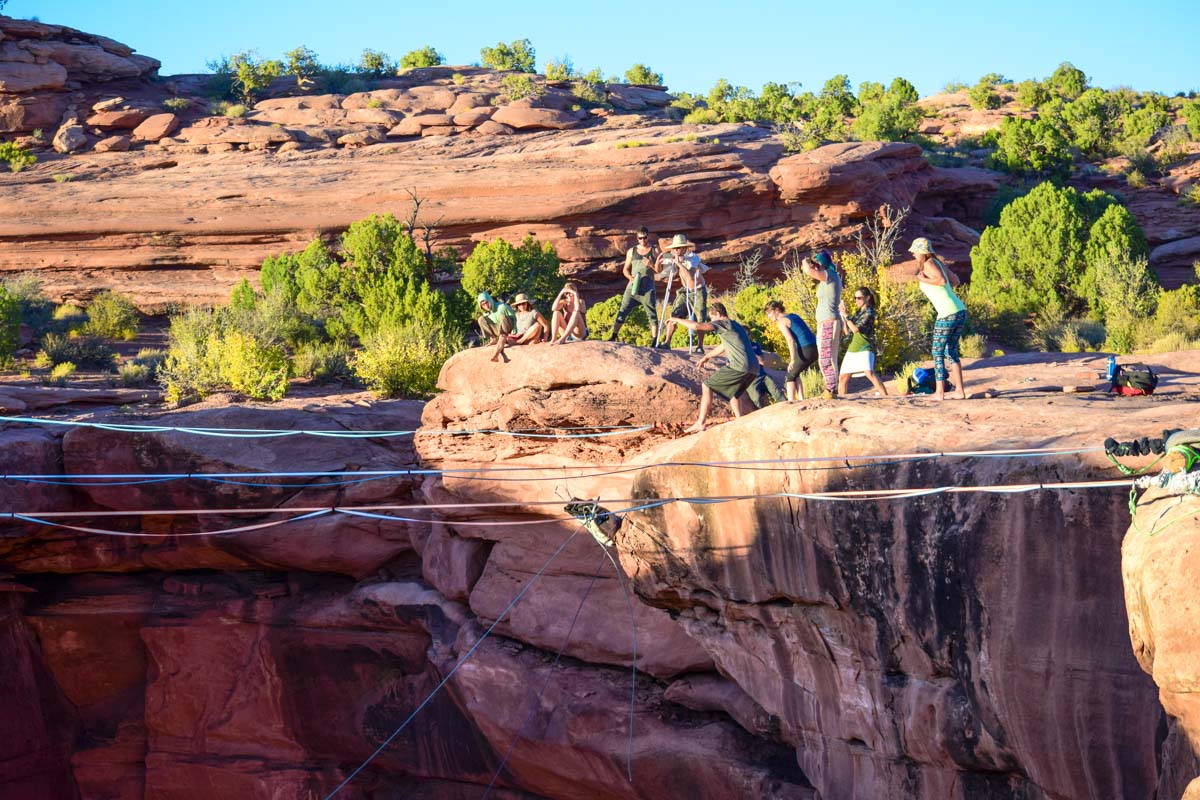
Day 1: Rigging the Swing
It took us the entire next day to rig up the swing and the fixed lines. (It’s something you really want to make sure you get right.) Quick overview of the setup: A highline and a safety line are fixed to a number of anchors bolted into the rock on either side of the canyon. These are secured with a number of backups, backing up the backups. Hanging around the high-lines is a large metal ring. In addition to the two ropes the jumper is tied to, there are directional ropes attached to it that run to either side of the canyon, used to haul the ring back and forth across the line.

After the jumper’s momentum slows and he/she is simply dangling in the canyon, a crew hauls the jumper over to the canyon wall via the directional rope. At this point, the jumper then needs to essentially run horizontal across the wall to swing over to a fixed line dangling from a ledge about 2/3 of the way up the canyon. The jumper then rigs up his/her ascending gear on the fixed line, and begins the 150+ foot climb to the ledge. After some progress is made up the line, the jumper unties from the two ropes, and continues to climb up the fixed line while the crew re-rigs the setup for the next jumper.
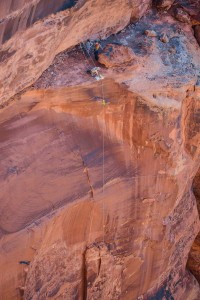
It takes a while to self-ascend 150+ feet in the middle of a windy canyon. You have to cross a number of overhanging roof segments, untie pads attached with Prusiks (and retie them once you pass), and shimmy your way from dangling on the rope to standing on the ledge. Once your feet are on semi-solid ground (the ledge), you disassemble your rig, and begin a 50-yard traverse across the narrow sandstone outcropping. At the widest, the ledge is about 10 feet – at the narrowest, only a couple. You continue to scramble across the boulders and uneven surfaces until you reach a rather sketchy section involving a little climbing, where another fixed line is waiting for you. At this point you self-belay up the edge, and scramble up into a narrow slit that leads into a cave. Once you’ve wedged into the cave and taken yourself off belay, you crawl through the openings until you get to a beam of light shooting into the cave from the surface 15 feet above. At this point you climb out through the awkward, narrow opening to eventually arrive at the surface of the canyon, nowhere close to where you began.
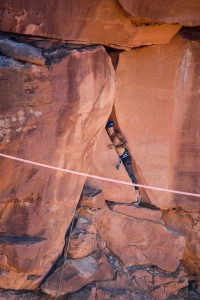
In other words, jumping is the easy part.
Day 2: The Lead-Up
Now I’ve dabbled in rock climbing over the years, but I’m definitely no BASE jumper. I’ve never even seen a paraglider, gone skydiving, or taken a leap off a bungee jump platform. At that point, I’d never even crossed a high-line or hung suspended on gear in the middle of a canyon. I’m definitely poorly acquainted with hucking myself off cliffs. Luckily, everyone else had been doing it for years.
When I first tied in and walked up to the Canyon’s edge, I knew I would need a few seconds of clarity before I could bring myself to jump. It wasn’t a question of fear; I had enough trust in the rigging and my climbing abilities to know that I was going to get out alive. The issue was the silent noise inside my head – my body’s rebuttal to my brain’s request to directly violate the human instinct of self-preservation.

Every time I found momentary pause in both the mental and environmental chaos, a gust of wind would shoot a plume of sand and leaf particles up from the canyon and into my face. There was no fighting these moments, all I could do was take a step back away from the edge and start the clarification process all over again.
As I missed lull after lull, I realized that the elements would not give me the time I so badly wanted. After 10 minutes of searching for it, I grew to accept that that the perfect moment was not coming. More importantly, I didn’t need a perfect moment. I would have to find one that was good enough and just make peace with it on the way down.
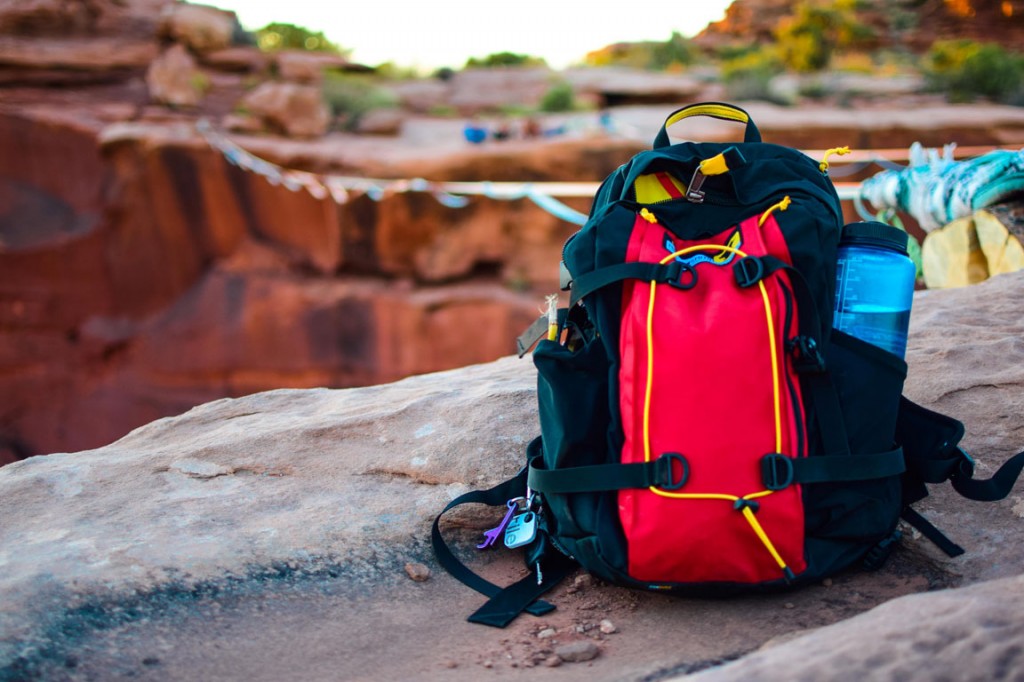
Day 2: Jump 1
Once I finally took the leap, I had an odd reaction. I didn’t feel an adrenaline rush as I started plummeting towards the earth. I didn’t feel fear or panic or any emotion other than a heightened awareness of the wind whooshing upwards past my head and neck. After a few seconds of free fall, the ropes engaged and gently began to swing me out through the canyon. I could hear everyone up top hooting, so I gave out a “YEW!” to let them know I was all good, then leaned my head against the ropes and continued to swing back and forth in silence.
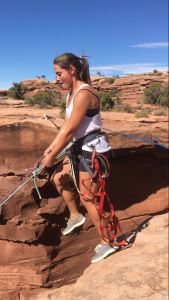
At this point I checked in with myself… how are you feeling? For the most part, I felt nothing. If anything, I felt almost disappointed. I felt like I should have been excited, I should have been stoked, I should have been afraid, I should have been emotionally engaged, but mostly I was just disappointed in myself for standing on the edge so long. Worse yet, I realized that though the decision to jump was 98% for myself, there was an ugly 2% that did it for those watching me. I loathed that 2% more than anything at that moment.
I had a long time to think about these things as I embarked on the half hour technical struggle out of the canyon. By the time I was back on solid ground, I was significantly less happy than I was when I jumped from it. I gave and took high-fives and played it off – I was indeed grateful for the opportunity, and wanted to make sure I expressed that. Afterward I went out on a high-line and hung my body over the abyss (something I definitely should have done beforehand) and my mood improved a little… but I didn’t feel right.
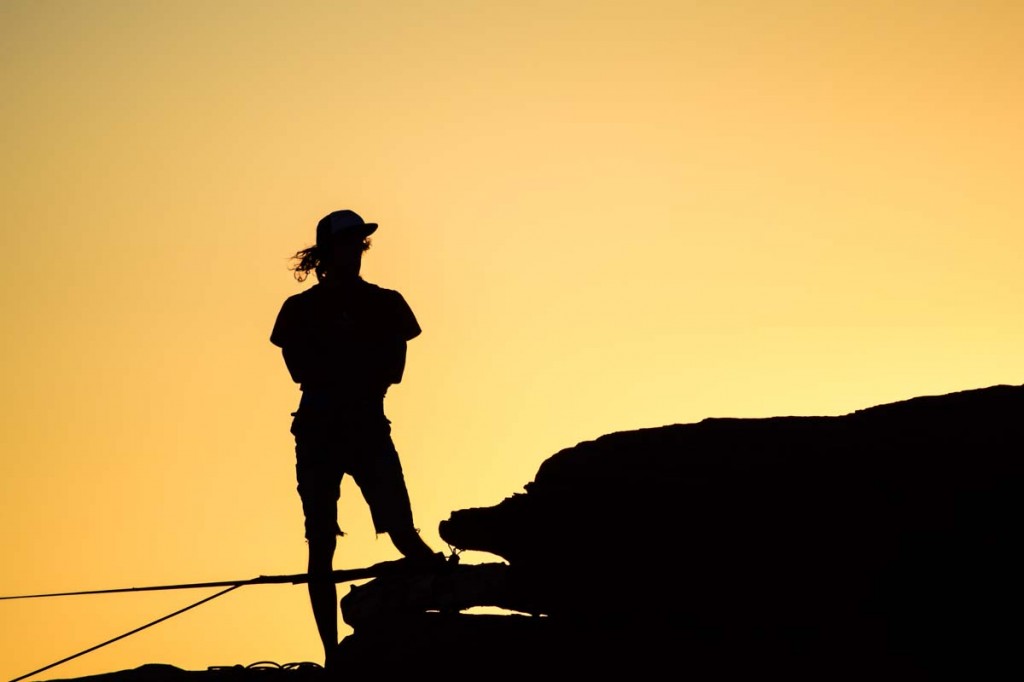
Day 2: Jump 2
After we had both jumped, Conor and I had to make a run to town to restock on water and grab some food. While we were sitting in front of the quesadilla truck talking about it, however, it became very clear to me that I desperately needed to try to jump again. We rushed back over the dirt roads and made it to the canyon just as the sun was setting.
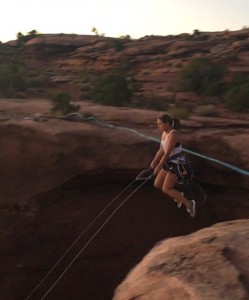
Miraculously, the crew immediately offered me the opportunity to go again. Without hesitation, I ran over to the launch spot, tied into the ropes, and leapt off. Though I wound up with an awkward body position in the air, the whooshing feeling of free-fall was exciting this time, the swing out gratifying, and the experience engaging. Right after I jumped, the dark set in quickly and the wind grew even stronger. I scrambled my way up with a headlamp and embraced the healthy dose of anxiety that comes when your well-being is entirely up to your own devices. Despite the sketchy conditions, I felt extraordinarily gratified that the jump was 100% my own this time.
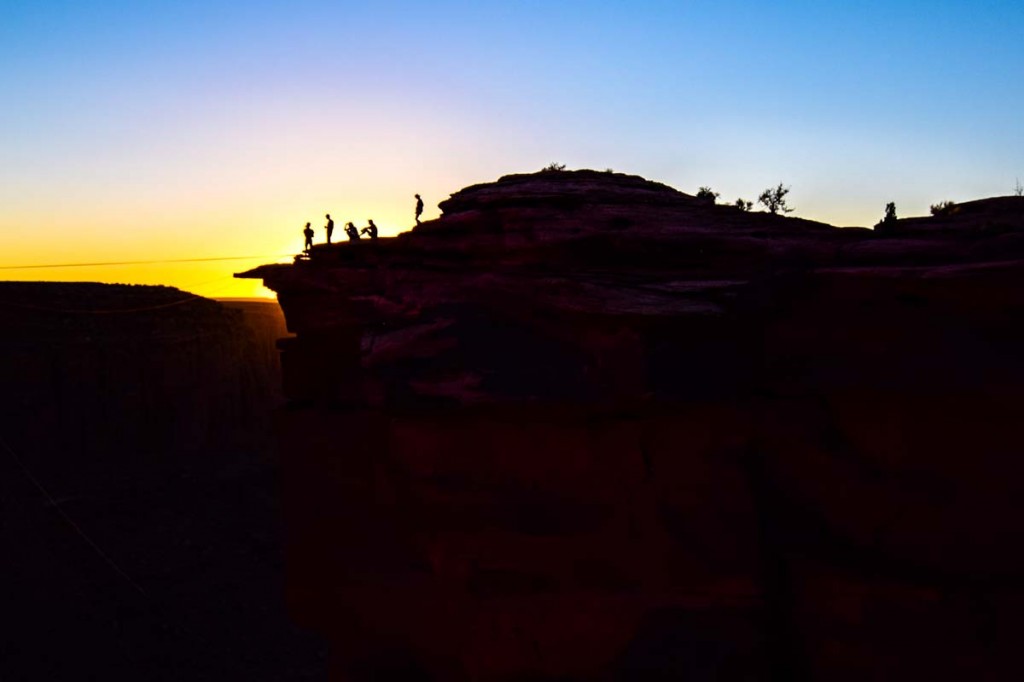
Needless to say I slept amazingly in the Morrison 2 tent that night. I think there’s something about the desert – especially Moab – that naturally pushes humans outside their comfort zones. Perhaps it’s the lack of environmental comfort, or abundance of geological features from a time when world was entirely different. Either way, I’ve grown to admire all it has to offer, as well as those who turn it into their playground.

WOW, I don’t think I could jump from a cliff like that! Love the photography though! BTW, I love your packs! -Alicia @ http://www.GirlonaHike.com
saw some footage from this online, ITS AWSOME!
@sam_treesmith